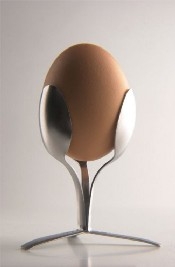How to create an egg science fair project
By Catalogs Editorial Staff

Create a great science fair project with something you eat for breakfast.
Every school year, elementary school students are faced with the prospect of coming up with a project for the science fair. If you are stuck for an idea, help is here. An egg science fair project can be just what you’re looking for.
Float an egg
Supplies:
A clear glass container
One raw egg
Sugar
Salt
First, do some reading on buoyancy so that you understand what makes an object float or sink.
Write your hypothesis. A hypothesis is a statement that tells what you believe will happen when you perform your experiment. For instance, “In plain water, an egg will sink because it is more dense than the water. If I change the density of the water, the egg will float.”
Now, fill your container with tap water and add your egg. What happens? Write down your observations.
Now, begin adding salt to the water one teaspoon at a time. Record your observations after each teaspoon. Does the egg eventually float?
Try the same experiment with sugar.
Draw pictures or take photos of each step of your experiment, then organize them on poster board with your explanation of the project and the results.
Bounce an egg
Supplies:
Raw egg
Vinegar
Clear plastic cup
Do your research first. What is a chicken eggshell made of? Write down your findings.
Try dropping an egg on the pavement outside. Record what happens. Did the egg bounce or break? Why?
Now, place your egg in the cup and pour vinegar over the egg until it is completely covered.
Check on your egg often during the next three days. Write down your observations of the egg. What is happening to the shell? Draw pictures or take photos to support your observations.
At the end of three days, use a plastic spoon to carefully remove your egg from the cup. Drop the egg gently from a height of four to five inches. What happens? Does the egg bounce? How has the egg changed while in the vinegar solution? What does this tell you about the chemical reaction between calcium and vinegar?
Use poster board and drawings or photos to illustrate what happened during your project and write about what you discovered.
~
Spin an egg
Supplies:
A flat surface, like a tabletop
One hard-boiled egg
One raw egg
A willing participant like a parent or sibling
Can a person tell the difference between a raw egg and a hard-boiled egg without breaking the shell? Write a hypothesis to show what you will be trying to prove.
Mark the eggs A and B with a permanent marker. Be sure to write down which one is raw and which one is hard-boiled!
Have your participant observe, touch, smell, and handle both eggs carefully. Ask what they observe about each egg and write down their findings. Finally, have your participant make a guess as to which egg is raw and which is hard-boiled.
Spin Egg A on its side on the tabletop. Note how fast it spins. Stop the egg’s spin by touching it with a finger and then removing the finger. Does the egg stop or continue spinning?
Now, repeat the process with Egg B, making all the same observations.
Reveal which egg is raw and which is cooked and then write your conclusions. Why did the raw egg continue spinning? Why did the hard-boiled egg spin faster?
Shrink an egg
Supplies:
A glass juice bottle
A hard-boiled egg
A piece of paper
Matches
Gently crack the egg’s shell and peel the shell away. Place the egg on the opening of the bottle. Will it fit?
Remove the egg. Under a parent’s supervision, light a small piece of paper with a match and then drop it into the bottle. Place the egg over the opening of the bottle and watch the egg get sucked inside.
What happens to air molecules when they are heated and cooled? Why was the egg sucked into the bottle? Did the egg really get smaller? Write up your conclusions. On science fair day, bring all of your supplies and perform the experiment for your class.
Squeeze an egg
Supplies:
A sink
Raw chicken eggs
First, do some reading on the architectural structure called a three-dimensional arch. Why is it considered so strong?
Next, stand over the sink with an egg in your hand. Wrap your fingers completely around the egg and squeeze. Squeeze a little harder. Does the egg break? Why or why not? Make sure you aren’t wearing any rings or jewelry that would make the pressure uneven.
For your project, explain why the egg is able to withstand so much pressure when it is evenly distributed, but why it will break when tapped in one spot.
Eggs are fascinating things and an egg science fair project can be a big hit at your school. Just be sure to have paper towels around to clean up any mess!
Popular Savings Offers











